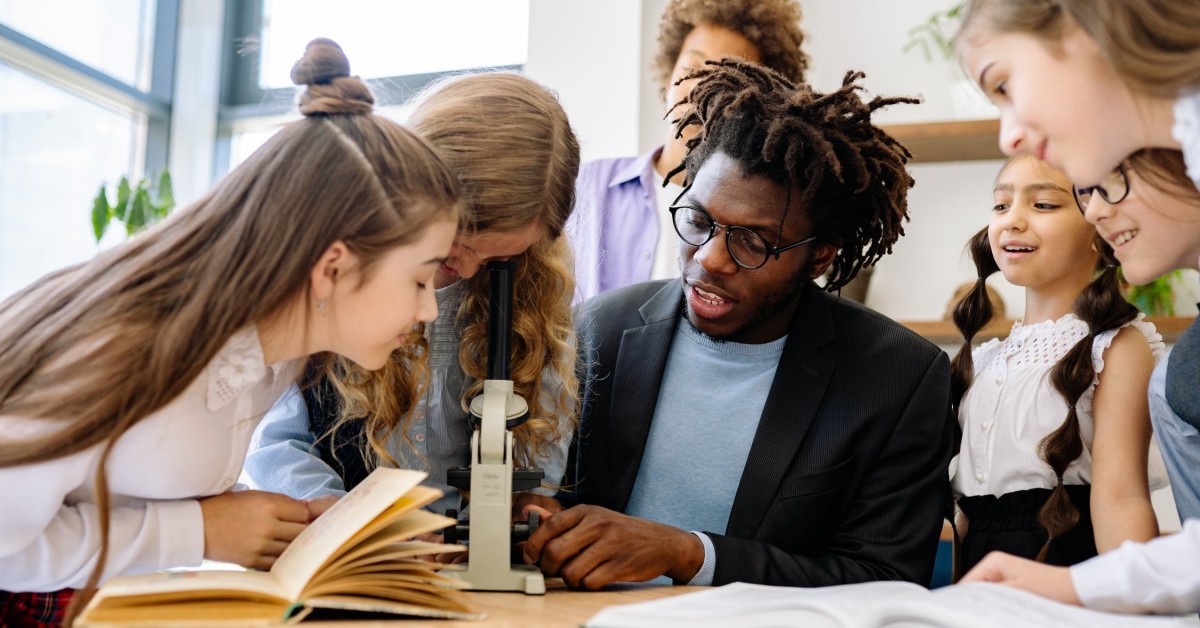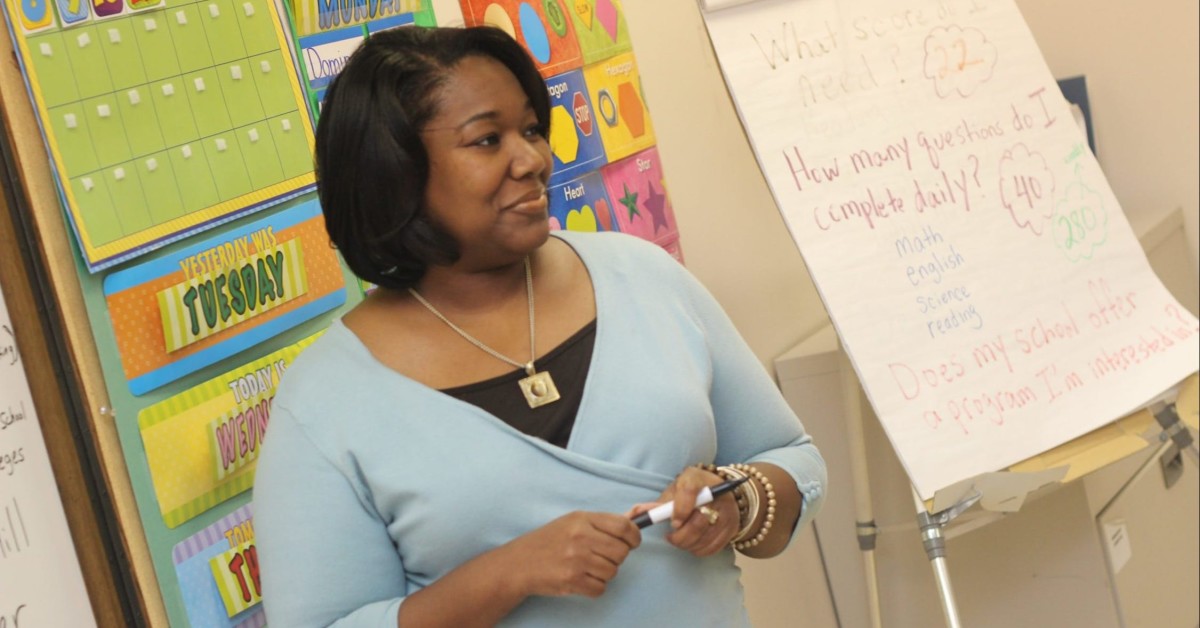
Is It Hard to Earn a Master of Arts in Teaching While Working?
Earning a master's degree in teaching while working full-time is [...]
This website may earn a commission if you make a purchase after clicking on a product link in this article
In my first year as a teacher, there were times when I felt like nothing I was doing worked.
Sometimes I wanted to leave the classroom and never go back. There were some times when students talked back, or ignored me altogether. And there were others when students seemed not to care about class at all — no matter how much I wanted them to, or how much I cared.
I have since learned strategies that can help manage students, build a supportive class culture, and promote healthy relationships. Here are a few things I understand now that I wish I had known then.
I was told very sternly that the way I managed my class on the first day of school would determine my success (or failure) for the rest of the year. That was a terrifying thought, and it haunted me for weeks leading up to the first day of class. It made sense, too. I knew that children would form impressions about me within the first few minutes of meeting me, as would I of them. I knew that I had to show them I was in charge.
On the first day of school, I used all of the management strategies I had learned, expecting perfect results. I came into class with (what I hoped was) apparent confidence, and I was firm in my statements about expectations. Rather than conveying a presence of toughness, however, I felt that my students knew I was faking it. And if a given technique didn’t work the first time, I was afraid to retry it later — to me, that just emphasized my utter failure. When I saw children being mean to each other, I felt as though I had set myself up to fail for the rest of the year, and the first day of school had not even come to an end yet.
Over time, I learned to be more patient with myself as well as the students. Everyone needs time and space to learn and to practice new skills. With consistency and persistence, a teacher can gradually release control as students internalize classroom routines. With patience, whole-group lessons can turn into small-group work and personalized instruction. It was difficult for me to accept this at first, but learning is supposed to look messy in the first days (or even weeks) of school.
While it’s not something I did in my first year, I now find that daily reflection is crucial — not only so I can revise things that do not work, but also so I can acknowledge and continue to implement the things that do. Class dynamics, I learned, are fluid; they’re certain to change over time. I often use teambuilding games to allow students the opportunity to form connections, work together, and establish boundaries. Ultimately, a teacher can influence, support, and manage, but that teacher cannot control the decisions that students make. I don’t see my job as teaching routines anymore, but as teaching children.
| University and Program Name | Learn More |
|
New York University:
Master of Arts in Teaching
|
|
|
Merrimack College:
Master of Education in Teacher Education
|
I was so excited for my first reading lesson in front of a third-grade class. I had a detailed lesson plan in hand, down to the minute. I rehearsed it beforehand and learned the script. I was ready for my debut performance.
What I didn’t anticipate when I was practicing for the show was the audience. For some reason, I felt a sense of shock when the children sat down in front of me. When I was preparing, the focus was all on myself — I was the star of the show.
Well, the children decided differently.
Some of them were visibly bored after the first few minutes of what I thought was a fascinating reading, “Spiders” by Gail Gibbons. As I pushed on, I knew that I had lost the interest of most of the kids. By the end of the lesson, it felt like my rehearsal again — I was all alone.
What I didn’t realize then is that being prepared does not mean being inflexible. On the contrary, teachers should have the right preparation in place to enable flexibility: a learning objective, the content of the lesson, and the physical materials needed for class.
One year later, I taught another lesson about “Spiders.” This time, I started with a story of how I once saw my grandmother catch a spider by its leg with her bare hands, and how I’d feared them ever since. (As it happens, the story popped into my head moments before the lesson — I was organically thinking about the topic at hand.) I asked the children if they had ever felt that way, and many of them could relate. After the lesson, I had the class make pamphlets to show what they had learned. I left room for them to insert their own ideas and questions, and they were actively involved in the learning process.
I still view all of my lessons as performances, but my goals are different now than when I started. Preparation provides me with structure and support, but when the time comes, the audience is what the performance is all about.
Initially, I was certainly not the kind of teacher who popped into the principal’s office for a chat. During my first year (and since), I often felt like I had more to do than I had the time and energy for. The administration did not seem overly concerned with what I was doing, and I preferred things that way. The common way to take out frustrations was by venting with other first-year teachers who had plenty of their own overwhelming concerns to share. Although we were supposed to be able to accept and implement feedback we received, we were all the happier if the dreaded feedback never came.
Now, I wish that I had sought out help and advice when I needed it — not just from administrators, but from other, more experienced teachers I trusted. Just because support was not readily available did not mean I couldn’t get it.
Let a supervisor know you’re eager to observe other teachers. I learned unexpected teaching tricks by doing this, even though it wasn’t a designated part of my schedule or job. I now find that speaking with more experienced teachers about dealing with specific, difficult situations is very helpful.
If going into another classroom presents a logistical nightmare, there are many online tools that can help facilitate professional development for first-year teachers. Blogs like Edutech for Teacherscan also offer ongoing support outside of the immediate school network.
In addition, I now use a self-evaluation strategy to help me prepare for a feedback session with a supervisor or administrator: SWOT, which stands for strengths, weaknesses, opportunities, and threats. This enables me to reflect on what I bring to a given situation, as well as what the environment that I am placed in can offer. Identifying personal strengths and weaknesses and separating these from the environmental supports and demands of the job can provide a way to prepare for conversations about professional growth and to alleviate fears about receiving feedback. Check out more information about the SWOT technique, and complete your own Personal SWOT Analysis{: target=”_blank” rel=”nofollow” }.
I now know that a growth mindset is key in staying optimistic and solution-oriented throughout the school year. When you make your needs known and take the first step in initiating conversations about the supports that you require, you will be well on your way to feeling connected and supported, both by the school community and outside networks.
I was leading my first class meeting. This was a time when students got together to acknowledge each other, discuss problems, and come up with solutions. The class was participating and following along, until one child burst out with a rude comment about another student. I responded by reprimanding the student who had made the comment, a public reaction that set him off even more. The class meeting was disrupted, and I could not find a way to bring back the calm energy that had existed before. By pushing back and arguing with one student, I had made the conflict worse (and derailed the whole class in the process).
Since then, I have adopted a new mindset that has tremendously helped me in preventing escalation of conflicts among and with students. In a teacher training session, education consultant Rick Smith explained that it is important for a teacher not to react with frustration when a student is aggressive. He uses the analogy of a wave on the ocean. If you face it head-on and try to push, it’ll topple you over. If you choose instead to dive under it, the wave’s energy will stick to its own path, but you’ll emerge on the other side unscathed.
An experience in a second-grade class brought this analogy to life for me. One student, who happened to look a lot younger than his classmates, raised his hand to ask a question. His accent was heavy, and he was difficult to understand. The rest of the class, including the other teacher sitting at her desk, laughed at him. I felt angry and hurt, but took a deep breath before speaking. Instead of retaliating with a knee-jerk response, I let the weight of the moment crash, as if it was a wave breaking on the shore. After an uncomfortable silence, I acknowledged the student’s courage and began a conversation about compassion with the class. Going “under the wave” allowed me to overcome a challenging situation and not get dragged down by it, as I had in my first year of teaching.
Another strength of this approach to classroom management is that not all issues can or should be addressed directly in the moment. Delaying a consequence is a strategy that can save a lot of hurt feelings, especially in situations where the teacher and the student are both frustrated.
“You know, kids don’t learn from people they don’t like,” said Rita Pierson, a teacher with 40 years of experience, in a TED talk called “Every Child Needs a Champion”. As I look back on my first year “in the trenches,” I vividly remember a student who rebelled against learning.
This boy was one of the most advanced readers in my class, proudly flying through the Harry Potter series as if he had a broomstick of his own. He made funny sounds as he read to himself, and I could almost see the story light up in his eyes. From the way he confidently walked into the classroom and organized his materials every day, I could tell he was a leader. I observed those qualities in him and smiled to myself.
He was at times, however, defiant. This frustrated me more than when any of the other students in the class misbehaved. I felt like he was acting up to spite me, and the more I confronted him, the more he refused to follow my directions. I could tell that he no longer liked me by his blank stares and silent protests. He began to do the opposite of what I asked, and it became a game I could not win.
I wish I had known then that relationship-building in the classroom comes first. I didn’t put enough effort into making this boy feel liked, respected, and understood; he reciprocated, in turn, and our interactions felt like a battle I had initiated and perpetuated by harping on the student’s misbehaviors time and time again. The best-case outcome of this battle, lest we forget, would be me winning an argument with an 8-year-old.
I know now to prioritize relationships with all of my students. A rule that I try to live by, especially for the students who are tougher to connect with, is to make three positive acknowledgments for every one corrective comment. Without positive reinforcement, students who are noncompliant or defiant are likely to become increasingly troublesome in class.
In a poignant presentation at the 2015 Boston Book Festival, educator and author Vanessa Rodriguez showed that according to brain science, learning in a classroom is a human interaction. Understanding a child’s existing knowledge and emotion state, for example, should take precedence over teaching as a mechanical transfer of knowledge. The more accurate and nuanced a teacher’s theory of mind is with regard to every learner, the more effective the instruction will be.
I make it a point as a teacher — before any other learning can happen — to convince my students that I enjoy spending time with each and every one of them. (The actor in me picks up the slack in cases in which that is not always entirely true.) A classroom full of healthy relationships makes everyone in it happier — and more inclined to learn.
Looking for a supportive environment for your child? Check out the Noodle school search, and take a look at this checklist of 10 things to consider when choosing a school .
Questions or feedback? Email editor@noodle.com

Earning a master's degree in teaching while working full-time is [...]

If you're looking to quickly (and inexpensively) earn your MAT [...]

The beauty of online teacher residency programs is that after [...]

Washington, DC-based teacher residency programs offer the opportunity to earn [...]

Florida desperately needs teachers. If you're thinking about a teaching [...]
Categorized as: Teaching, Education & Teaching